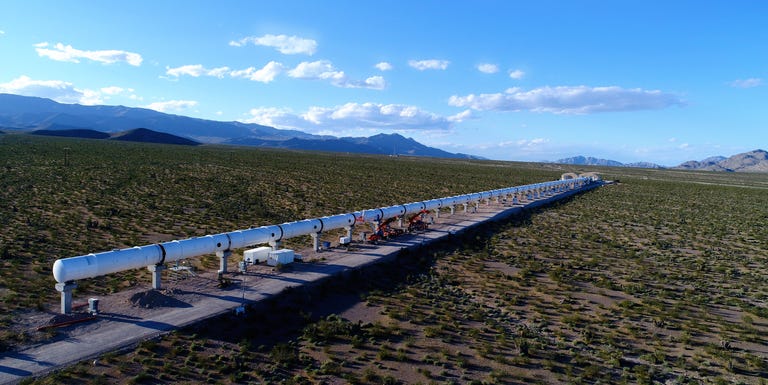All Your Questions About the Hyperloop, Answered
It’s been four years since Elon Musk shared his vision for transcending ships, trains, cars, and planes. Will the hyperloop ever be more than a vision?

Hyperloop One
By Kevin Dupzyk
In August 2013, disappointed by the high-speed-rail system being built through the center of California, Elon Musk released a white paper called Hyperloop Alpha, describing a system of pod-cars shooting through vacuum tubes at nearly 800 mph. The paper ended with a plea for “the community” to work on an “open source transportation concept”—he was too busy, he said, to work on it himself. Here are the key questions that have arisen since.
Has anyone taken up Musk’s challenge to develop hyperloop technologies?
Yes—initially, two main companies, one called Hyperloop Technologies and another called Hyperloop Transportation Technologies (HTT). The former, now called Hyperloop One (H1), boasts a flashy venture-capitalist cofounder and more than $150 million in funding. The latter has taken “open source” to heart and is more like a very well-organized consortium of engineers from around the world.
Was Hyperloop One cofounded by a guy legally named Brogan BamBrogan?
Yes. Although BamBrogan left and earlier this year formed his own company, Arrivo, one of a handful of other small startups working on the hyperloop. And a variety of academic teams are working on pod-car prototypes, spurred by a series of competitions hosted by Musk at SpaceX HQ.
So Musk isn’t totally leaving this up to “the community”?
No. SpaceX built a three-quarter-mile-long track, and has hosted two competitions (a third is scheduled for summer 2018), rewarding things like design, safety, and speed. At the second competition, the winning team hit 201 mph.
Are there other test tracks?
A Dutch company born from Musk’s first competition built a 30-meter-long test track in Europe. While the SpaceX track is only six feet in diameter, its track is full-size—it can handle tests with cars big enough to carry passengers. And H1 has the full-size DevLoop, a 500-meter test track outside Las Vegas. It hit 192 mph in a test in July.
It sounds like the technology is coming along.
It is. A team from NASA examined the feasibility of the hyperloop, purely from a technological standpoint, and found it doable. Everyone agrees the technology itself isn’t the challenge.
Then what’s the challenge?
There are two: cost and land acquisition. Musk’s original paper said hyperloop would be cheaper than existing high-speed-transit options, but at this point, with the technology still in development, there’s no consensus on the validity of his estimates. There is consensus on the second challenge: It’s incredibly difficult to acquire land on this scale in the U.S. For this reason, many companies are exploring projects in other countries. One of the more promising startups, TransPod, is based in Canada; H1 has a deal with the government of Dubai; and HTT with South Korea. It’s entirely possible we’ll see a working hyperloop abroad before we get one in the U.S.
At least we’ve got Musk. It’s too bad he’s staying so hands-off.
About that. In July, Musk tweeted he’d gotten “verbal govt approval” to build a hyperloop underneath the Atlantic seaboard with the help of his tunneling outfit, The Boring Company.
Why did he get back in?
The most interesting of many possible reasons: Creating a near-vacuum inside a tube is challenging and costly in Earth’s atmosphere, but on Mars atmosphere is negligible. The hyperloop could be the public transit system of Musk’s Red Planet colony.
In other words, we might see a working hyperloop on Mars before the U.S.?
Possible, but unlikely: SpaceX is currently planning its first, unmanned mission to Mars in 2020—probably a long shot—and that’s also about when most hyperloop startups are targeting for their first operable line.
No comments:
Post a Comment